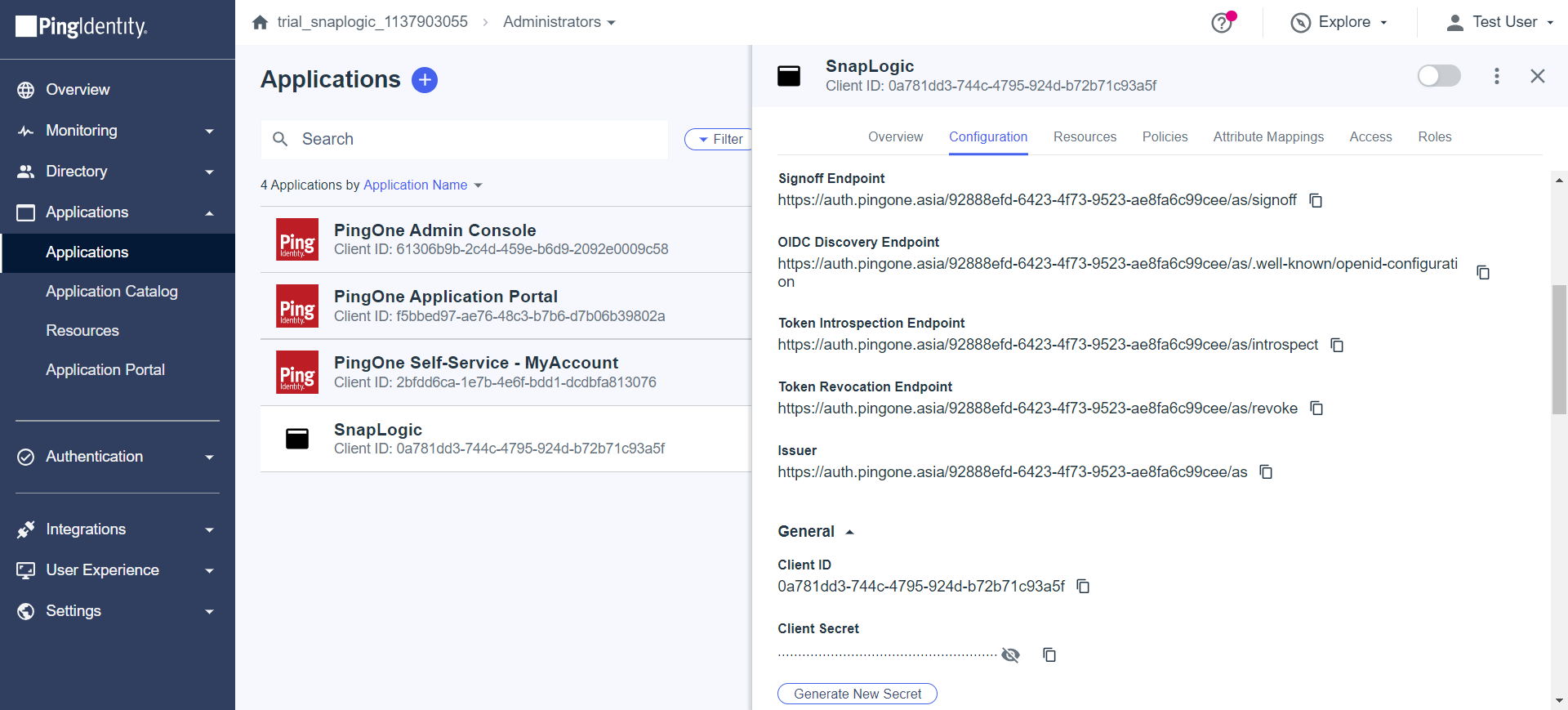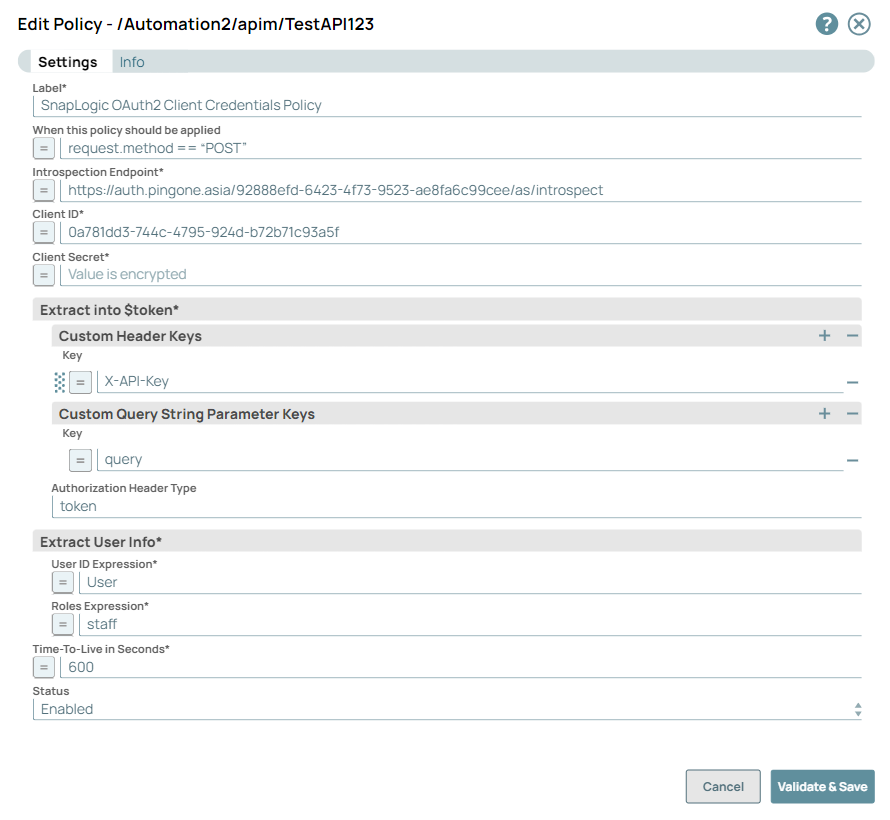| Table of Contents | |||||||||||||||||||||
|---|---|---|---|---|---|---|---|---|---|---|---|---|---|---|---|---|---|---|---|---|---|
|
Overview
You can use this policy to authenticate users with a token in your OAuth 2.0 environment. This implementation is based on the Client Credential flow from Okta.
| Noteinfo |
|---|
Authentication Policy Requirement All Authentication policies require the Authorize By Role policy to authenticate the API caller correctly. For example, you can configure this policy to add the role “admin” to the client and then configure the Authorize By Role policy to authorize users with that role. |
Verified Providers
SnapLogic verified the following Authentication providers for this policy:
...
This policy might work with other authentication providers not listed above but has not been tested and verified.
| Info |
|---|
Known IssueWe do not support Azure AD for the OAuth 2.0 Client Credentials policy because Azure AD does not provide an introspection endpoint. |
Prerequisites
The Oauth2 authentication server must be configured to accept the client ID/secret from the basic auth header during introspection.
OAuth 2.0 Framework for Client Credentials Grant Type
The OAuth 2.0 Client Credentials grant flow is a way for an application (the client) to directly request an access token from an authorization server without involving a user. This flow is suitable for scenarios where the client application needs to access its own resources or when user authentication is not necessary.
The OAuth 2.0 Client Credentials Policy lets a client app access other services securely, without needing to know or store any user passwords in SnapLogic's OAuth2 environment to authenticate using its client ID and client secret. The client requests an access token from the authorization server, which it can then use to access protected resources on its own behalf. The authorization server provides a token introspection endpoint to validate the access token as an additional layer of security to the Client Credential OAuth2 framework.
OAuth Roles
Client: The client is an application that is requesting access to resources on another web service. The client authenticates itself using its own credentials (client ID and client secret).
Authorization Server: The authorization server authenticates the user's identity and issues access tokens to the application once authorization is granted.
Mapping Out the Protocol Flow
...
Client Credentials Grant Flow
Client Registration: The application is registered with the Identity Provider such as Ping Identity, Okta, Auth0, which issues Client ID, Client Secret, and Token Introspection Endpoint. Client ID and Client Secret are used to authenticate the application to Identity Provider.
Policy Configuration: Configuration of the policy for the API endpoint with Client ID, Client Secret, and Token Introspection Endpoint.
Token Request: When the application needs to access the API endpoint, it sends a request to the Identity Providers token endpoint, including its client ID, client secret.
Token Issuance: Identity Provider validates the application's credentials and, if they are correct, issues an access token to the application. This access token represents the authorization on behalf of the application to access the API endpoint.
Resource Access: The application can now use the access token to access the API endpoint. The application includes the access token in the Authorization header or query of its API requests as configured in the Client Credentials OAuth2 Policy.
| Info |
|---|
|
Policy Execution Order
The OAuth 2.0 Client Credential policy executes after early-stage request validation policies, like IP Restriction.
| Multiexcerpt include macro | ||||
|---|---|---|---|---|
|
Settings
| Info |
|---|
All expression enabled fields take expressions from the SnapLogic Expression Language and the API Policy Manager functions. |
Parameter Name | Description | Default Value | Example |
|---|---|---|---|
Label | Required. The name for the API policy. | OAuth2 Client Credential | GitHub OAuth 2.0 Policy |
When this policy should be applied | An expression enabled field that determines the condition to be fulfilled for the API policy to execute. For example, if the value in this field is request.method == "POST", the API policy is executed only if the request method is a POST. | N/A | request.method == “POST” |
Introspection Endpoint | Required. The mechanism for client servers to obtain information about the access token. The response from this token introspection endpoint will be stored in $response and can be referenced in User ID Expression and Roles Expression. | N/A | https://auth.pingone.com/2f6b6ab3-1fa7-4a7d-ba4d-00dbebd6d056/as/introspect |
Client ID | Required. The ID of the application registered with the OAuth2 provider. | N/A | jdoe@beignet.com |
Client Secret | Required. The client secret for the application registered with the OAuth2 provider. You can also reference a secret from a 3rd-party Secrets Manager vendor by entering an expression. | N/A | chocolatE |
Extract into $token | Required. Specifies the location to find the key in the request. If one of the given locations is not found, this API policy will pass the request through to the next API policy. | N/A | N/A |
Custom Header Keys | The names of the headers that can contain the key. If more than one header is given, they will all be checked. Click + to add more custom header keys. | N/A | X-API-Key |
Custom Query String Parameter | The names of the query parameters that can contain the key. If more than one name is given, they will all be checked. Click + to add more custom query string parameters. | N/A | access_token |
Authorization Type | If the key is in the Authorization header, this value is used as the “type” to check. | Token | Key |
Extract User Info | Required. Specifies how to extract information about the user from the working object. | N/A | N/A |
User ID Expression | Required. An expression that returns a string to be used as the user ID. | N/A | $response.email |
Roles Expression | Required. An expression that returns the list of roles this user is in. | N/A | $response.groups.map(group => group.name) |
Time-To-Live in Seconds | Required. The number of seconds the token is valid for before it is re-validated. | 600 (10 minutes) | 700 |
Status | Specifies whether the API policy is enabled or disabled. | Enabled | Disabled |
Example to Configure the OAuth 2.0 Client Credentials API Policy with Ping Identity
Prerequisites
Apply Authorization by Role Policy
Verified Authentication Providers for this Policy, such as Okta or Ping Identity.
Example Workflow with Ping Identity Authentication Provider
| Info |
|---|
The OAuth 2.0 Client Credentials Policy is typically used in a machine to machine authenticate scenarios where a human/user is not involved. |
You can use Ping Identity for the authentication process:
Set up the application in Ping identify to obtain the Client Credentials and Token Introspection Endpoint for use in the Policy.
Use the obtained Client Credentials and Token Introspection Endpoint in the Policy setup:
Field names with an '*' (Asterisk symbol) are mandatory.
Parameter Name | Field Type | Example | |
|---|---|---|---|
Label* | String | SnapLogic OAuth2 Policy | |
When this policy should be applied | String/Expression | request.method == “POST” | |
Introspection Endpoint* | String/Expression | https://auth.pingone.asia/92888efd-6423-4f73-9523-ae8fa6c99cee/as/introspect | |
Client ID* | String/Expression | 0a781dd3-744c-4795-924d-b72b71c93a5f | |
Client Secret* | String/Expression | OwPmby3VbPpMJjKG5vXG4QciClg2xZw6oXnrXvDufRBIgbOHK5-PXvlLg0ml.DDG | |
Extract into $token* | N/A | ||
Customer Header Key | String/Expression | X-API-Key | |
Custom Query String Parameter | String/Expression | query | |
Authorization Header Type | String | token | |
Extract User Info* | N/A | ||
User ID Expression* | String/Expression | User | |
Roles Expression* | String/Expression | staff | |
Time-To-Live in Seconds* | String/Expression | 600 (10 minutes) | |
Status | Dropdown List | Enabled | |
...
See Also


